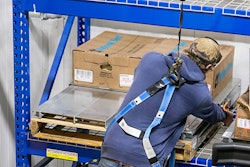
June marks the start of National Safety Month in the United States. Across the country, people work together to reduce injuries within the workplace, on the road and at home. Each week highlights a different safety topic that should be of concern: emergency preparedness, wellness, falls and driving.
According to the Bureau of Labor Statistics, 5,190 people died while working in 2016. Kevan Orvitz, founder and CEO of workplace health and wellness solutions company MEGAComfort, says that the most common workplace injuries are over exertion, slips, trips and falls.
“With over exertion, it’s not the amount of time people are doing the activities, it’s how they are doing it,” Orvitz explains. Over exertion injuries occur from lifting, pushing, pulling or carrying motions. Often times, injuries are a result of people performing incorrectly. According to a study by Liberty Mutual Group Insurance, over exertion injuries cost American businesses upwards of $15 billion each year.
Consequences of over exertion are fatigue and strain on the body. Standing for eight to nine hours a day takes a toll on one’s body, often leaving employees tired and sore. Although it’s been said that “sitting is the new smoking,” standing for long periods of time can lead to muscular and skeletal disorders.
A common solution to combat fatigue is the use of anti-fatigue mats. While proven to reduce the stresses on legs, feet and joints, it can also be the cause of an injury. Anti-fatigue mats have been reported to be the source of an employee tripping and hurting themselves because they weren’t installed properly. When choosing a mat, it is important to note that mats should not slip or create any sort of tripping hazard. The mat should also have curved edges to help further prevent any injuries.
An alternative solution that Orvitz suggests is the use of anti-fatigue insoles. MEGAComfort provides anti-fatigue insoles to all employees, acknowledging that the money invested in employee safety is less than the thousands spent during absenteeism. The anti-fatigue insoles reduce the risks of slips, trips and falls and help transition away from floor mats.
While there are many ways to prevent injuries, the first thing that needs to be done is a workplace assessment. The employee is the employer’s most valuable asset, so they must be involved.
“I’m a big believer in involving both sides of the equations,” Orvitz says. “Involve the employers and the employees.”
The company needs to identify their needs, problems and issues during its assessment and move forward from there.
After completion, businesses must keep safety on the mind and implement training sessions on a bi-monthly basis.
“Safety should always be on the mind,” Orvitz says. “Safety training should be top of mind. You know that saying ‘safety first?’ I believe in that every day.”
When offering training sessions, it is necessary to offer a variety of lessons for employees since everyone learns differently. Orvitz suggests using an e-learning method for the younger generation that has grown up with technology and is now entering the work force, while having a hands-on session for those that are physical learners. He also encourages getting employees involved with the training since they are the ones doing the work. Often times, employees offer great suggestions on how to make the workplace safer.
Orvitz notes that an important aspect of employee safety is their overall wellness. When taking into account an employee’s wellness you must factor in: physical, mental and financial.
In order to improve employee physical wellness, companies are starting to offer more “perks” to their staff. During a recent on-site visit, Orvitz visited a facility that provided a gym to their employees and had a health clinic on-site for employees who may have fallen into hard financial times. He urges companies to also provide workers with mental wellness options as an avenue to get help they need.
“Even though it’s National Safety Month, employee wellness is very important and is highlighted and brought out to people as something that means something to employers,” he says.
Orvitz adds that companies don’t have to strain themselves in ensuring employee wellness. Incentives can be put into place so that workers can help maintain themselves, and for every $1 that is invested in wellness programs, the company has a return on investment four-times that amount.

















